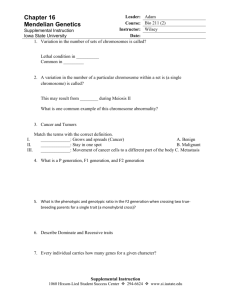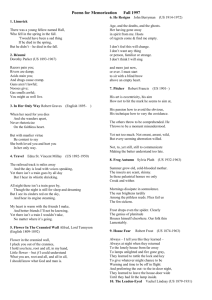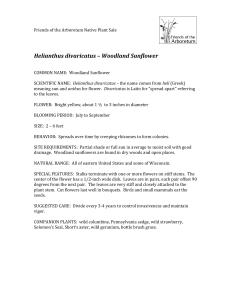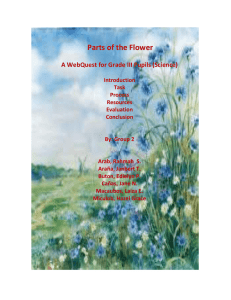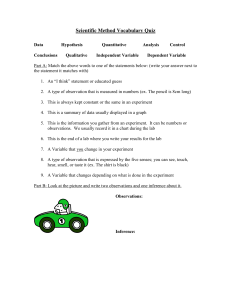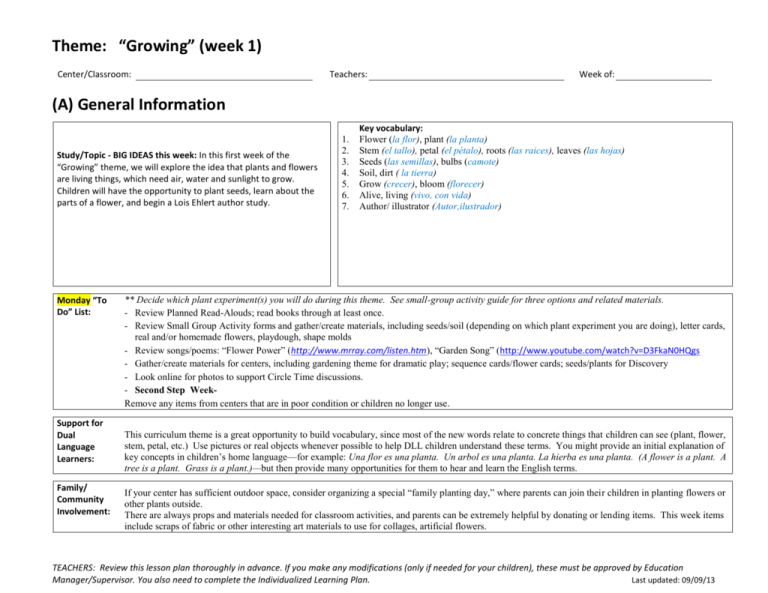
Theme: “Growing” (week 1)
Center/Classroom:
Teachers:
Week of:
(A) General Information
Study/Topic - BIG IDEAS this week: In this first week of the
“Growing” theme, we will explore the idea that plants and flowers
are living things, which need air, water and sunlight to grow.
Children will have the opportunity to plant seeds, learn about the
parts of a flower, and begin a Lois Ehlert author study.
Monday “To
Do” List:
Support for
Dual
Language
Learners:
Family/
Community
Involvement:
1.
2.
3.
4.
5.
6.
7.
Key vocabulary:
Flower (la flor), plant (la planta)
Stem (el tallo), petal (el pétalo), roots (las raices), leaves (las hojas)
Seeds (las semillas), bulbs (camote)
Soil, dirt ( la tierra)
Grow (crecer), bloom (florecer)
Alive, living (vivo, con vida)
Author/ illustrator (Autor,ilustrador)
** Decide which plant experiment(s) you will do during this theme. See small-group activity guide for three options and related materials.
- Review Planned Read-Alouds; read books through at least once.
- Review Small Group Activity forms and gather/create materials, including seeds/soil (depending on which plant experiment you are doing), letter cards,
real and/or homemade flowers, playdough, shape molds
- Review songs/poems: “Flower Power” (http://www.mrray.com/listen.htm), “Garden Song” (http://www.youtube.com/watch?v=D3FkaN0HQgs
- Gather/create materials for centers, including gardening theme for dramatic play; sequence cards/flower cards; seeds/plants for Discovery
- Look online for photos to support Circle Time discussions.
- Second Step WeekRemove any items from centers that are in poor condition or children no longer use.
This curriculum theme is a great opportunity to build vocabulary, since most of the new words relate to concrete things that children can see (plant, flower,
stem, petal, etc.) Use pictures or real objects whenever possible to help DLL children understand these terms. You might provide an initial explanation of
key concepts in children’s home language—for example: Una flor es una planta. Un arbol es una planta. La hierba es una planta. (A flower is a plant. A
tree is a plant. Grass is a plant.)—but then provide many opportunities for them to hear and learn the English terms.
If your center has sufficient outdoor space, consider organizing a special “family planting day,” where parents can join their children in planting flowers or
other plants outside.
There are always props and materials needed for classroom activities, and parents can be extremely helpful by donating or lending items. This week items
include scraps of fabric or other interesting art materials to use for collages, artificial flowers.
TEACHERS: Review this lesson plan thoroughly in advance. If you make any modifications (only if needed for your children), these must be approved by Education
Manager/Supervisor. You also need to complete the Individualized Learning Plan.
Last updated: 09/09/13
(B) Materials to Enhance Children’s Play
Blocks
Dramatic Play
Keep any items from previous week(s) that children
were particularly engaged with.
Add: Gardening theme:
Plastic flowers, pots, vases, watering cans, empty
seed packets, aprons, gardening tools
Books about flowers and gardens, or any other
items that might help children explore growing
plants and flowers.
Art
Add:
“Flower cards” – image of flower, with numeral in
center; children put that number of seeds on the
flower
Library/Writing
Add:
“Flower Sculpture” materials – playdough, shape molds,
paper shapes, popsicle sticks, etc. (see Small-Group
Activity)
Flowers, plants, and/or pictures of them to inspire
children’s drawings
Discovery/Science
Add:
Read-aloud books for this week
Lois Ehlert books
Lois Ehlert Author Study poster
Sand and Water
Add:
Soil
Gardening tools/watering can
Fake plants, flowers or trees
Toys and Games
Add:
Children’s plant experiments (see Small-Group
Activity) and science journals
Additional live flower/plant to observe and draw (if
desired)
Variety of seeds to sort and examine; tweezers,
magnifying glasses
Music and Movement
Computers
Add:
Songs from this week (Garden Song, Flower Power)
available on CD to listen to; scarves or props to act
out songs
Add:
Outdoors
Cooking
Watering cans
Unit cubes, string, or measuring tape to measure plants, trees and flowers in the school yard
(C) Group Experiences
Monday
Arrival
Tuesday
Wednesday
Arrival: Attendance graph
Arrival: Attendance graph
Morning Circle:
Welcome song & one other
Morning Circle:
Welcome song & one other
Thursday
Arrival: Attendance graph
QOTD: “Did you see a
plant on your way to school
today?” (Y/N) Show
Friday
Arrival: Attendance graph
Morning Circle:
Welcome song & one other
© 2012 Acelero, Inc. All Rights Reserved. Uses are subject to the limitations set forth in your user agreement. Your right to use these materials is contingent upon remaining a current
SARGE subscriber with Acelero, Inc.
Monday
Tuesday
Opening
Circle
SS Puppet Script
Movement
Review daily schedule and
rules now and throughout
the day
Relaxation
Transitions
Closing
Circle
Transition: What do we
know about flowers?
Show picture or actual
example of a flower as a
prompt. Begin a KWL
chart by asking children
what they know about
flowers (where do you see
flowers? what do they need
to grow? etc.) and whether
there is anything they want
to learn about flowers.
Music/Movement: SS Song
&“Flower Power” by Mr.
Ray
(http://www.mrray.com/listen.h
tm)
Wednesday
Parts of a flower – Show
children a flower bulb that
is already in bloom (see list
of nontoxic plants at
http://www.ohsu.edu/xd/out
reach/oregon-poisoncenter/upload/Non-ToxicPlants.pdf). Talk about the
different parts: the seed
(bulb), roots, stem, leaves,
flower/petals. Elicit ideas
from children: what do the
parts feel/smell like? Why
do they think flowers have
leaves, stem, roots, etc?
Create or show a picture of
a flower, with its parts
labeled. Hang in Discovery
Area or near any flowers in
classroom.
Review daily schedule and
rules now and throughout
the day
And one other song etc.
Relaxation:
Transition: Mighty Minute
#35 My Name, Too!
Thursday
photos of a few different
types of plants – e.g. fern,
bush, flower, cactus. During
follow-up discussion,
explain that there are many
types of plants, including
many that are not flowers
Morning Circle:
Welcome song & one other
SS Story and Discussion
Review daily schedule and
rules now and throughout
the day
Transition:
Transition:
Music/Movement: SS
Song& Repeat “Garden
Song” and one other..
Music/Movement
“Garden Song (Inch By
Inch)” – Start with the
chorus and teach unfamiliar
vocabulary.
http://www.youtube.com/w
atch?v=D3FkaN0HQgs
And “Growing Like Plants”
(see below)
Music/Movement: “Flower
Power” by Mr. Ray
Relaxation:
Closing Circle:
Goodbye song
(http://www.mrray.com/listen.h
tm & one other
Transition: SS Brain
Builder-
Transition: SS Brain
Builder-
QOTD: “If you had a
garden, what would you
want to grow in it?”
(Vegetables/flowers) Copy
pages from Growing
Vegetable Soup and
Planting a Rainbow to
illustrate the two choices.
Review daily schedule and
rules now and throughout
the day
Transition:
Relaxation:
Friday
Closing Circle:
Goodbye song
Relaxation:
SS Skill ActivityTransition: KWL Chart:
Update chart by asking
children, “What have we
learned about plants and
flowers?”
Closing Circle:
Review progress of plant
experiment(s). Ask
children to predict what
changes they will see next
week.
Goodbye Song
Closing Circle:
© 2012 Acelero, Inc. All Rights Reserved. Uses are subject to the limitations set forth in your user agreement. Your right to use these materials is contingent upon remaining a current
SARGE subscriber with Acelero, Inc.
Monday
Tuesday
Group 1: Growing
Vegetable Soup by Lois
Ehlert or Planting a
Rainbow by Lois Ehlert
ReadAlouds
Group 2: The Carrot Seed
by Ruth Krauss
(Encourage children to
connect book to what
they’ve discussed and done
related to plants/flowers this
week)
Group 1: Plant Experiment
SmallGroup
Activity
Wednesday
Goodbye song
Group 1: The Carrot Seed
by Ruth Krauss
(Encourage children to
connect book to what
they’ve discussed and done
related to plants/flowers this
week)
Thursday
Group 1: Planting a
Rainbow
Special
Activities
Tangible
Acknowledgement System:
Outside
Inclement Weather Plan:
Group 1: SS BookGroup 2: Planting a
Rainbow
Group 2: SS Book-
Group 2: Growing
Vegetable Soup by Lois
Ehlert or Planting a
Rainbow by Lois Ehlert
Group 1: Flower Sculptures
Group 1: Measuring Plants
Group 2: Plant Experiment
Group 2: Flower Sculptures
Friday
Group 1: SS Skill Activity –
Group 2:Measuring Plants
Group 2: SS Skill Activity-
“Growing Like Plants” –
start down low, as seeds,
then slowly unfold, grow
taller and spread out leaves
(arms). Play appropriate
music and encourage
children to move like
flowers/trees in the breeze
Letter Patterns during
free choice time, see
activity guide
© 2012 Acelero, Inc. All Rights Reserved. Uses are subject to the limitations set forth in your user agreement. Your right to use these materials is contingent upon remaining a current
SARGE subscriber with Acelero, Inc.
Individual Child Planning Form
School Readiness Goal
Focus Domain(s)
Physical
Name
Approaches to
Learning
Language &
Literacy
Cogn./ Gen.
Knowledge
Child’s
Soc-Emotional
Focus
Date
Week of:
Strategy/Activity
Focus TS
GOLD
Objective(s)
Why Chosen?
(IFSP, TS Gold Report,
family input, conference
goal, etc.)
NOTE: Children with similar needs may benefit from
differentiated instruction (e.g. during small-group activity).
You can use the “Small Group” column at right to make notes
about possible groupings.
Example: 1. Routine – activity, state how you are
individualizing for this child.
CHECK when
implemented
Teachers:
Possible small-group?
Center/Classroom:
1.
2.
3.
1.
2.
3.
1.
2.
3.
1.
2.
3.
1.
2.
3.
1.
© 2012 Acelero, Inc. All Rights Reserved. Uses are subject to the limitations set forth in your user agreement. Your right to use these materials is contingent upon remaining a current
SARGE subscriber with Acelero, Inc.
2.
3.
1.
2.
3.
IFSP Child Planning
Child’s Name
IFSP Goals
Classroom Plan: What’s the Activity/Who’s Supporting the Child
*Please review all IFSP plans including Speech Only to ensure implementation of all classroom goals.
*For speech goals the what/who would be: Directed by the Speech Language Therapist
© 2012 Acelero, Inc. All Rights Reserved. Uses are subject to the limitations set forth in your user agreement. Your right to use these materials is contingent upon remaining a current
SARGE subscriber with Acelero, Inc.

